BaTi0.8B0.2O3 (B = Mn, Fe, Co, Cu) LNT Catalysts: Effect of Partial Ti Substitution on NOx Storage Capacity
Abstract
1. Introduction
2. Results and Discussion
2.1. Characterization of the Catalysts
2.2. Catalytic Activity
3. Materials and Methods
4. Conclusions
- In BaTi0.8B0.2O3 perovskites, Ti is partially substituted by Mn, Fe, Cu and, to a lower extent, by Co.
- The perovskite structure is modified or changed due to the insertion of B metal into the lattice:
- ○
- (i) For the BTCuO_2 catalyst, the tetragonal structure of the raw perovskite is distorted, a larger amount of oxygen vacancies is generated and Ba2TiO4 and BaCO3 appear as main minority segregated phases, but CuO is also detected.
- ○
- (ii) For Mn, Fe, and Co, the tetragonal structure changes to cubic, a lower amount of oxygen vacancies are formed and BaCO3 appears as segregated phase in the three catalysts. BTCoO_2 presents also BaCoO3 and Co3O4 segregated phases due to a lower degree of Co insertion into the framework.
- Due to the described modifications, all the BaTi0.8B0.2O3 catalysts are active for the NO oxidation to NO2, which takes place on oxygen vacancies and metal oxide sites, but only the BTCuO_2 catalyst (for which Ba2TiO4 segregated phase is identified), presents a significant NOx storage capacity. In fact, at 400 °C, the BTCuO_2 catalyst features the highest NSC which is close to that shown by platinum base catalysts.
Author Contributions
Funding
Conflicts of Interest
Appendix A
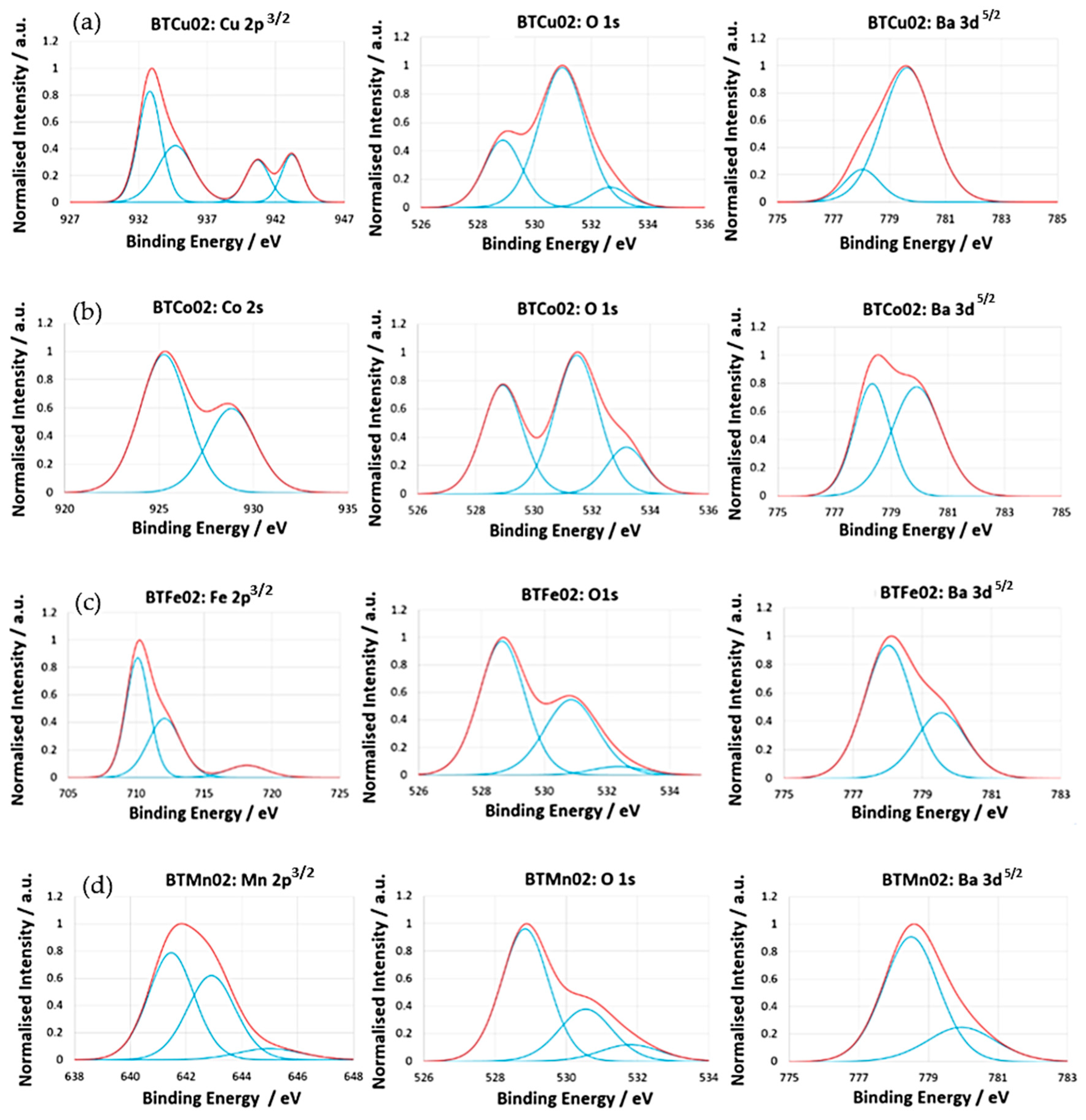
| XPS Transition | Binding Energy (eV) | Assigned Species |
|---|---|---|
| Cu2p3/2 | 932.9 | Cu(II) oxide surface species [25,26] |
| 934.8 | Lattice Cu(II) [11] | |
| 940.8 | Cu(II) satellite [25] | |
| 943.3 | Cu(II) satellite [25] | |
| Co2s | 925.28 | Co (II) oxide species [24] |
| 928.88 | Co(III) oxide species (Co3O4) | |
| Fe2p3/2 | 710.12 | Fe(II) oxide species [24] |
| 712.09 | Fe (III) oxide species [24] | |
| 718.15 | Fe (III) Satellite [25] | |
| Mn2p3/2 | 641.46 | Mn(III) oxide species (BaMn8O16) [27] |
| 642.90 | Mn(IV) oxide species (BaMn8O16, BaMnO3-x) [27] | |
| 644.98 | Mn satellite [26,28] |
References
- Hasan, A.O.; Abu-jrai, A.; Turner, D.; Tsolakis, A.; Xu, H.M.; Golunski, S.E.; Herreros, J.M. Control of harmful hydrocarbon species in the exhaust of modern advanced GDI engines. Atmos. Environ. 2016, 129, 210–217. [Google Scholar] [CrossRef]
- Polat, S.; Uyumaz, A.; Solmaz, H.; Yilmaz, E.; Topgül, T.; Yücesu, H.S. A numerical study on the effects of EGR and spark timing to combustion characteristics and NOx emission of a GDI engine. Int. J. Green Energy 2016, 13, 63–70. [Google Scholar] [CrossRef]
- Epling, W.; Nova, I.; Szanyi, J.; Yezerets, A. Diesel emissions control catalysis. Catal. Today 2010, 151, 201. [Google Scholar] [CrossRef]
- Breen, J.P.; Marella, M.; Pistarino, C.; Ross, J.R.H. Sulfur-Tolerant NOx Storage Traps: An Infrared and Thermodynamic Study of the Reactions of Alkali and Alkaline-Earth Metal Sulfates. Catal. Lett. 2002, 80, 123–128. [Google Scholar] [CrossRef]
- Gill, L.J.; Blakeman, P.G.; Twigg, M.V.; Walker, A.P. The Use of NOx Adsorber Catalysts on Diesel Engines. Top. Catal. 2004, 28, 157–164. [Google Scholar] [CrossRef]
- Pereda-Ayo, B.; González-Velasco, J.R. NOx Storage and Reduction for Diesel Engine Exhaust Aftertreatment. In Diesel Engine—Combustion Emissions and Condition Monitoring; Bari, S., Ed.; IntechOpen Ltd.: London, UK, 2013; pp. 161–196. ISBN 978-953-51-1120-7. [Google Scholar]
- Bowker, M. Automotive catalysis studied by surface science. Chem. Soc. Rev. 2008, 37, 2204–2211. [Google Scholar] [CrossRef] [PubMed]
- Epling, W.S.; Campell, L.E.; Currier, N.W.; Parks, J.E. Overview of the Fundamental Reactions and Degradation Mechanisms of NOx Storage/Reduction Catalysts. Catal. Rev. Sci. Eng. 2004, 46, 163–245. [Google Scholar] [CrossRef]
- Ad Hoc Working Group on Defining Critical Raw Materials. Report on Critical Raw Materials for the EU. 26 May 2014. Available online: http://www.catalysiscluster.eu/wp/wp-content/uploads/2015/05/2014_Critical-raw-materials-for-the-EU-2014.pdf (accessed on 15 January 2019).
- Royer, S.; Duprez, D.; Can, F.; Courtois, X.; Batiot-Dupeyrat, C.; Laassiri, S.; Aalmdari, H. Perovskites as Substitutes of Noble Metals for Heterogeneous Catalysis: Dream or Reality. Chem. Rev. 2014, 114, 10292–10368. [Google Scholar] [CrossRef]
- Albaladejo-Fuentes, V.; López-Suárez, F.E.; Sánchez-Adsuar, M.S.; Illán-Gómez, M.J. BaTi1−xCuxO3 perovskites: The effect of copper content in the properties and in the NOx storage capacity. Appl. Catal. A Gen. 2014, 488, 189–199. [Google Scholar] [CrossRef]
- Albaladejo-Fuentes, V.; López-Suárez, F.E.; Sánchez-Adsuar, M.S.; Illán-Gómez, M.J. Tailoring the properties of BaTi0.8Cu0.2O3 catalyst selecting the synthesis method. Appl. Catal. A Gen. 2016, 519, 7–15. [Google Scholar] [CrossRef]
- Modeshia, D.R.; Walton, R.I. Solvothermal synthesis of perovskites and pyrochlores: Crystallisation of functional oxides under mild conditions. Chem. Soc. Rev. 2010, 39, 4303–4325. [Google Scholar] [CrossRef]
- Wang, J.; Su, Y.; Wang, X.; Chen, J.; Zhao, Z.; Shen, M. The effect of partial substitution of Co in LaMnO3 synthesized by sol–gel methods for NO oxidation. Catal. Commun. 2012, 25, 106–109. [Google Scholar] [CrossRef]
- Dhal, G.C.; Dey, S.; Mohan, D.; Prasad, R. Study of Fe, Co, and Mn-based perovskite-type catalysts for the simultaneous control of soot and NOX from diesel engine exhaust. Mater. Discov. 2017, 10, 37–42. [Google Scholar] [CrossRef]
- Li, Z.; Meng, M.; Zha, Y.; Dai, F.; Zhang, J. Highly efficient multifunctional dually-substituted perovskite catalysts La1−xKxCo1−yCuyO3−δ used for soot combustion, NOx storage and simultaneous NOx-soot removal. Appl. Catal. B Environ. 2012, 121–122, 65–74. [Google Scholar] [CrossRef]
- Xia, F.; Liu, J.; Gu, D.; Zhao, P.; Zhang, J.; Che, R. Microwave absorption enhancement and electron microscopy characterization of BaTiO3 nano-torus. Nanoscale 2011, 3, 3860–3867. [Google Scholar] [CrossRef]
- Hayashi, H.; Nakamura, T.; Ebina, T. In-situ Raman spectroscopy of BaTiO3 particles for tetragonal–cubic transformation. J. Phys. Chem. Solids 2013, 74, 957–962. [Google Scholar] [CrossRef]
- Asiaie, R.; Zhu, W.D.; Akbar, S.A.; Dutta, P.K. Characterization of Submicron Particles of Tetragonal BaTiO3. Chem. Mater. 1996, 8, 226–234. [Google Scholar] [CrossRef]
- Torregrosa-Rivero, V.; Albaladejo-Fuentes, V.; Sánchez-Adsuar, M.S.; Illán-Gómez, M.J. Copper doped BaMnO3 perovskite catalysts for NO oxidation and NO2-assisted diesel soot removal. RSC Adv. 2017, 7, 35228–35238. [Google Scholar] [CrossRef]
- Moreno-Marcos, C.; Torregrosa-Rivero, V.; Albaladejo-Fuentes, V.; Sánchez-Adsuar, M.S.; Illán-Gómez, M.J. BaFe1−xCuxO3 Perovskites as Soot Oxidation Catalysts for Gasoline Particulate Filters (GPF): A Preliminary Study. Top. Catal. 2018. [Google Scholar] [CrossRef]
- Merino, N.A.; Barbero, B.P.; Eloy, P.; Cadus, L.E. La1−xCaxCoO3 perovskite-type oxides: Identification of surface oxygen species by XPS. Appl. Surf. Sci 2016, 253, 1489–1493. [Google Scholar] [CrossRef]
- Ponce, S.; Peña, M.; Fierro, J.L. Surface properties and catalytic performance in methane combustion of Sr-substituted lanthanum manganites. Appl. Catal. B Environ. 2000, 24, 193–205. [Google Scholar] [CrossRef]
- NIST X-ray Photoelectron Spectroscopy Database. (n.d.). Available online: https://srdata.nist.gov/xps/ (accessed on 15 January 2019).
- XPS Simplified Knowledge Base. (n.d.). Available online: http://xpssimplified.com/knowledgebase.php (accessed on 15 January 2019).
- Mingmei, W.; Qiang, S.; Gang, H.; Yufang, R.; Hongyiang, W. Preparation and Properties of BaCuO2.5 and Its Related Oxides. J. Solid State Chem. 1994, 110, 389–392. [Google Scholar] [CrossRef]
- Lan, L.; Li, Y.; Zeng, M.; Mao, M.; Ren, L.; Yang, Y.; Liu, H.; Yun, L.; Zhao, X. Efficient UV–vis-infrared light-driven catalytic abatement of benzene on amorphous manganese oxide supported on anatase TiO2 nanosheet with dominant {001} facets promoted by a photothermocatalytic synergetic effect. Appl. Catal. B Environ. 2017, 203, 494–504. [Google Scholar] [CrossRef]
- Liu, P.; He, H.; Wei, G.; Liu, D.; Liang, X.; Chen, T.; Zhu, J.; Zhu, R. An efficient catalyst of manganese supported on diatomite for toluene oxidation: Manganese species, catalytic performance, and structure-activity relationship. Microporous Mesoporous Mater. 2017, 239, 101–110. [Google Scholar] [CrossRef]
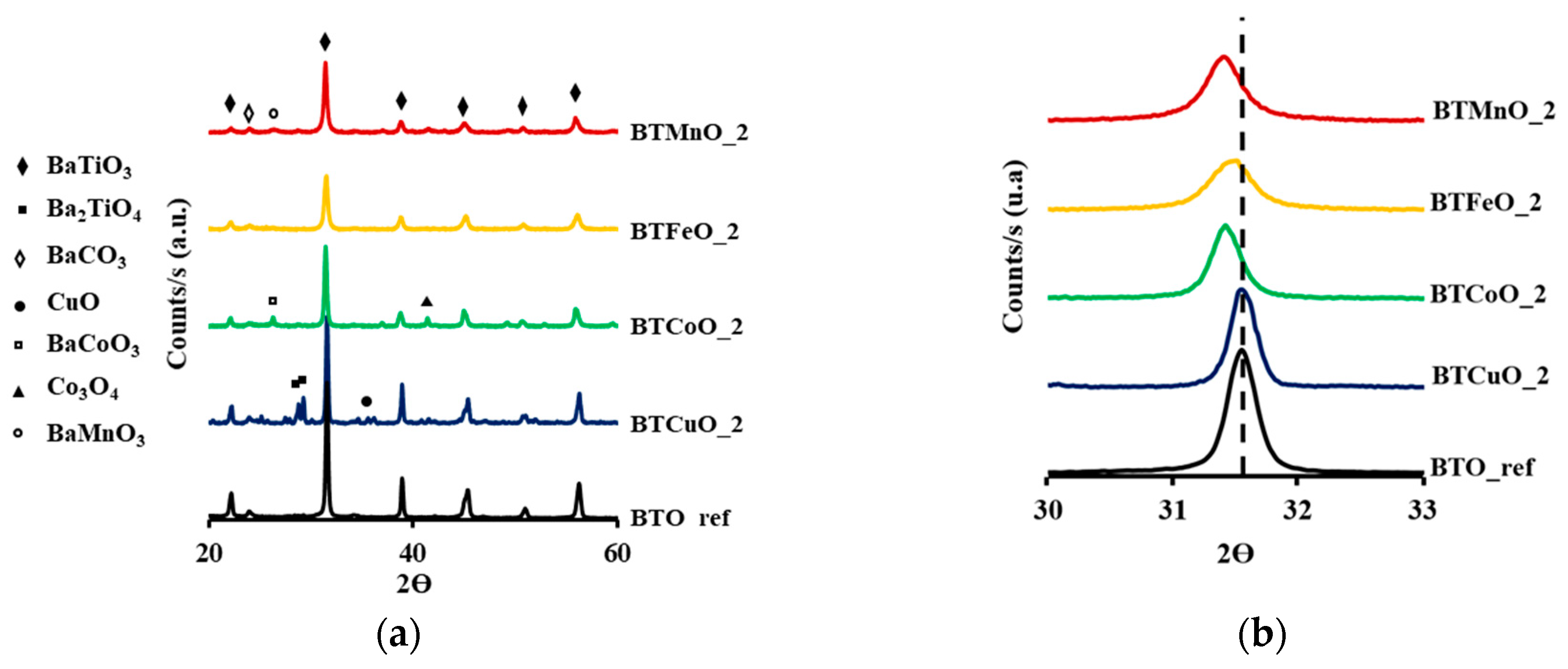
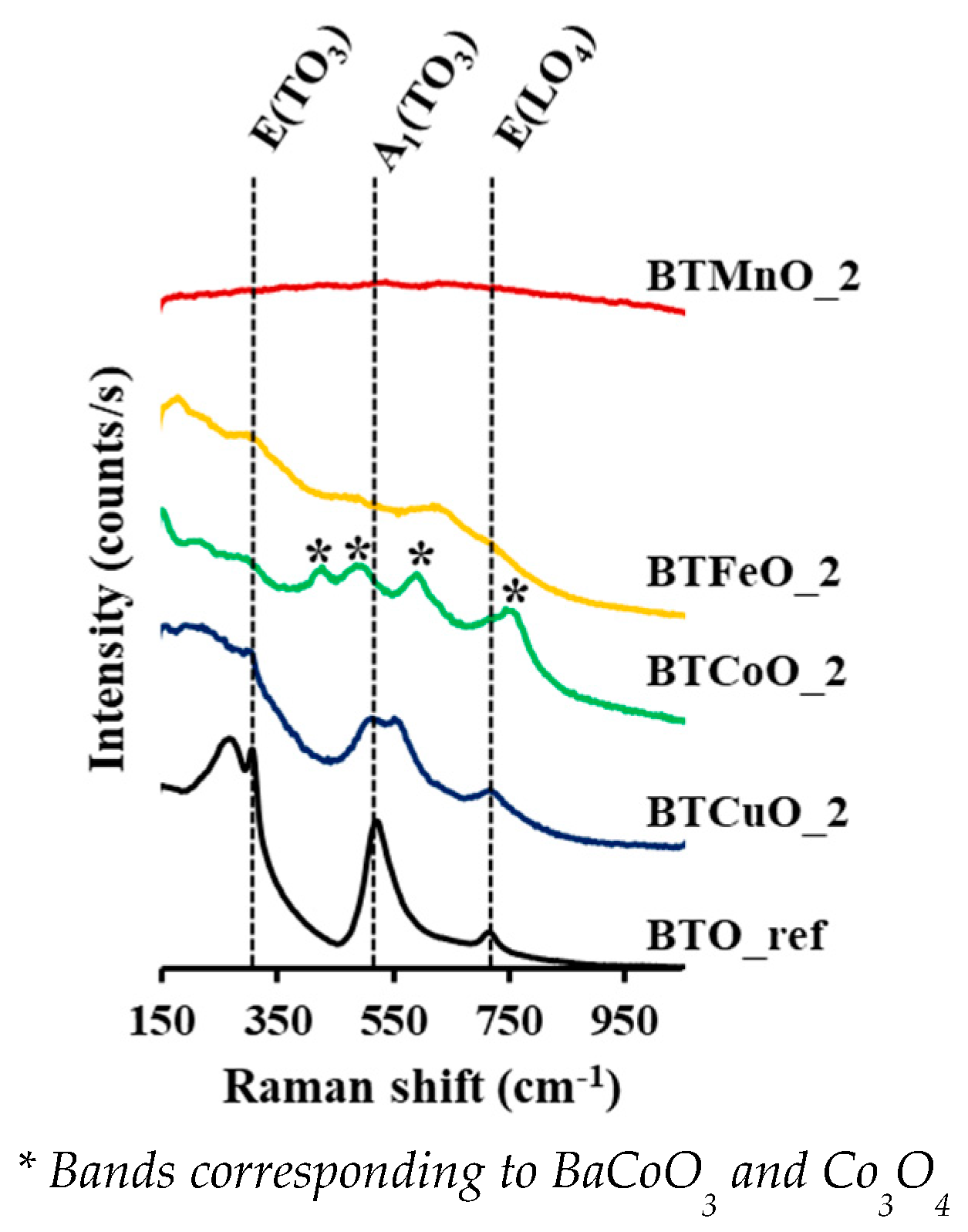
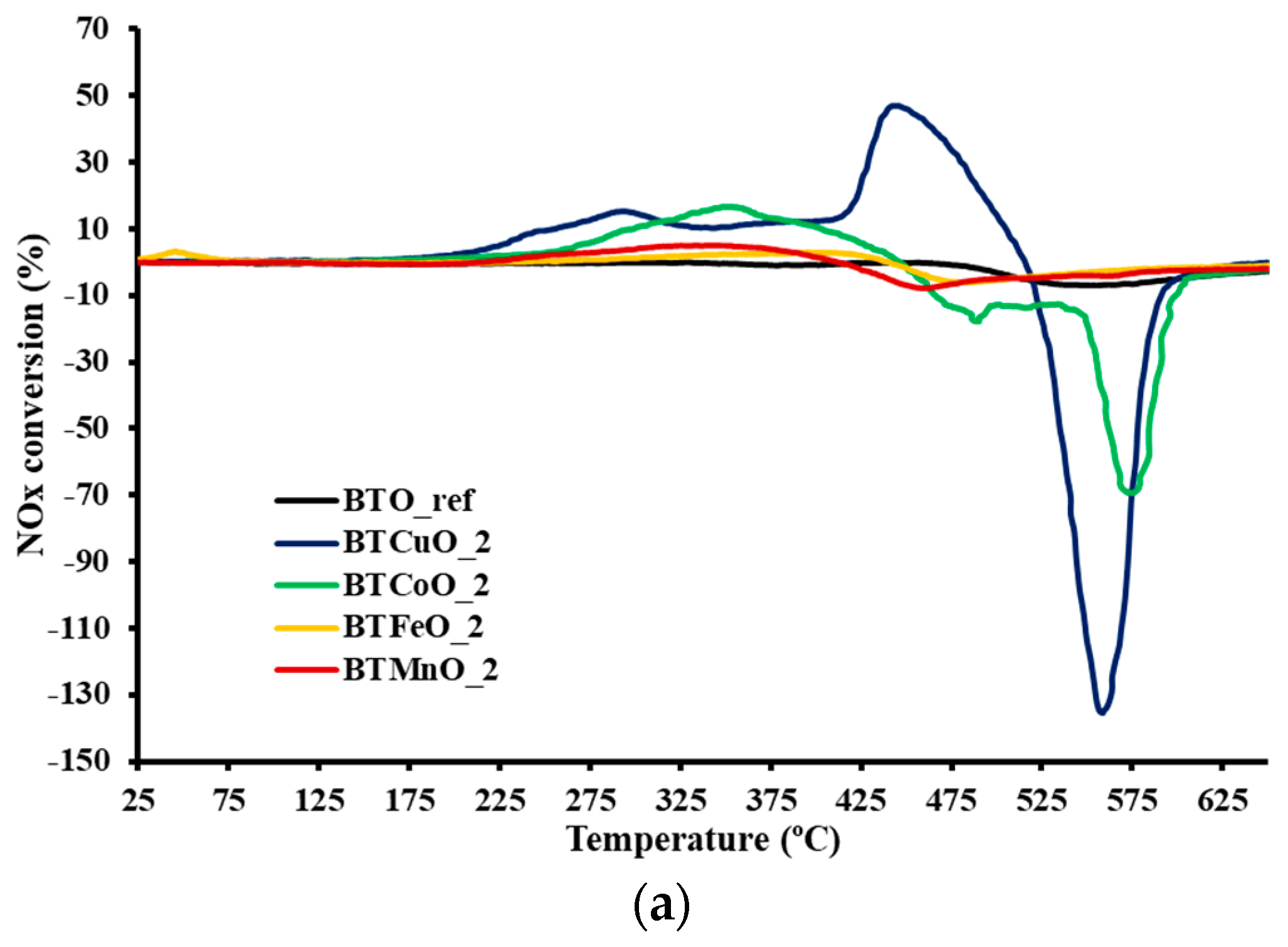
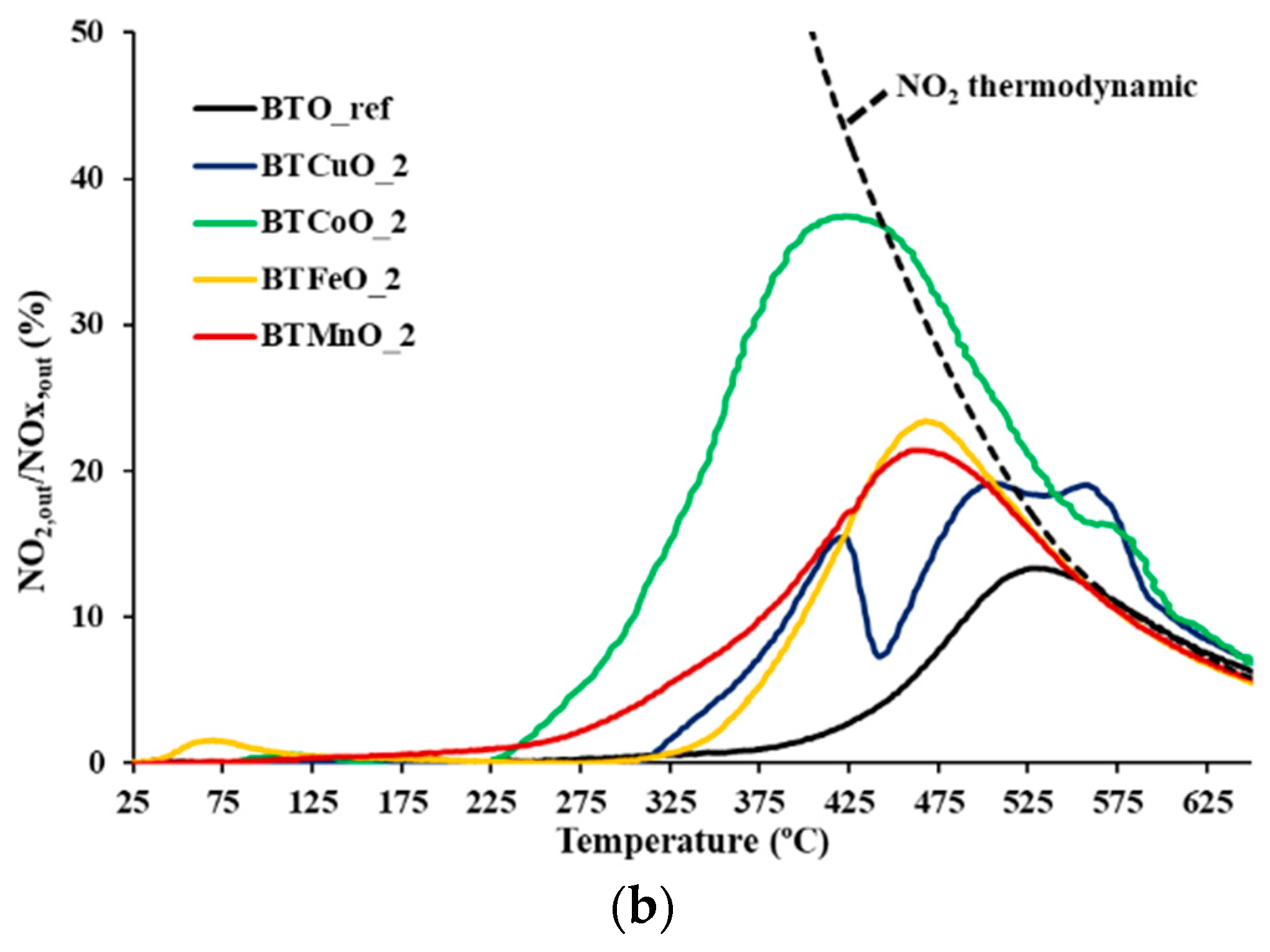
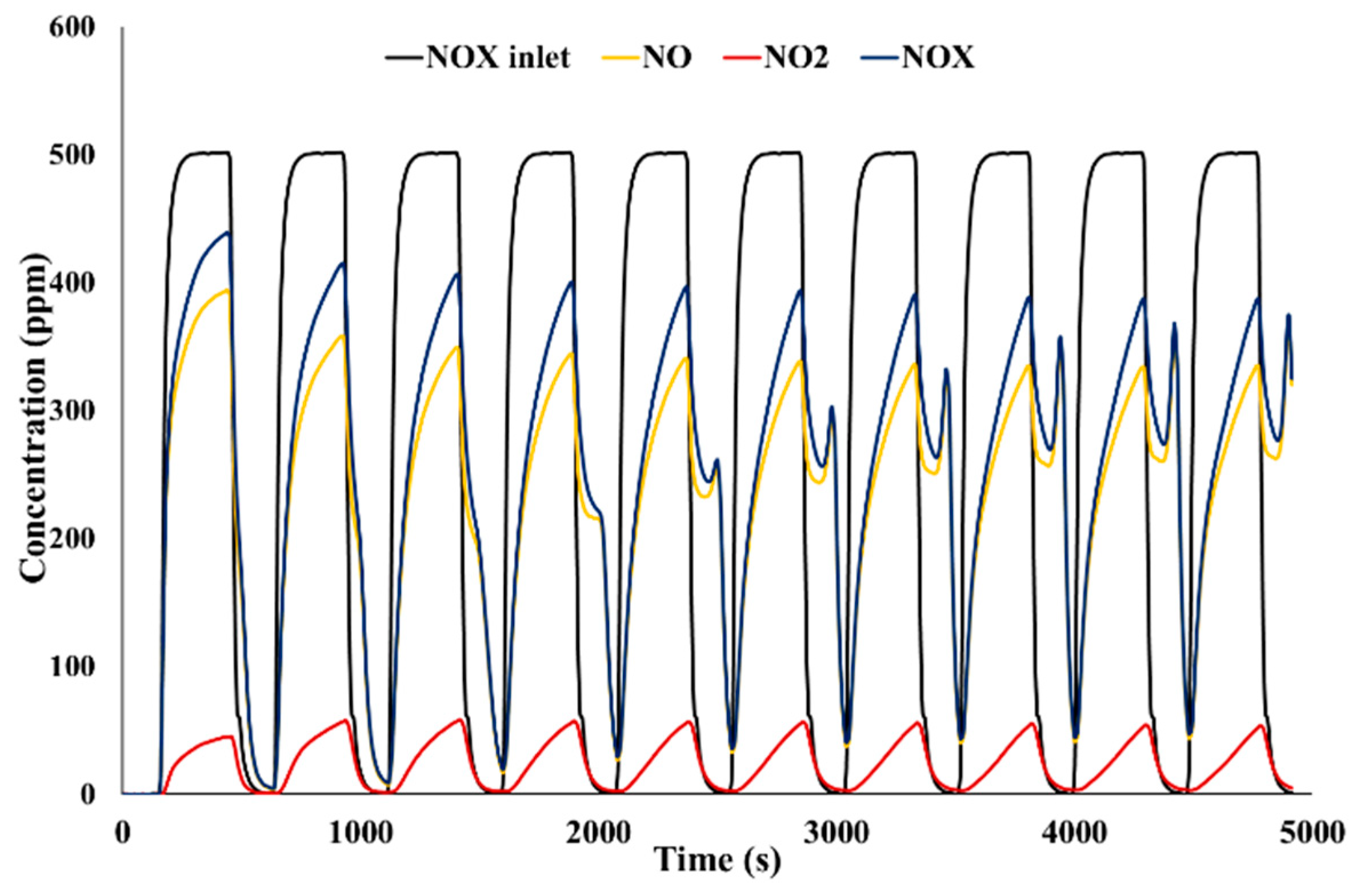
| Catalyst | Nomenclature | SBET (m2/g) | Bexp (wt%)/ Bnom (wt%) | B/Ba+Ti+B 1 | Olattice/Ba+Ti+B 2 |
|---|---|---|---|---|---|
| BaTi0.8Mn0.2O3 | BTMnO_2 | 13 | 5.2/5.4 | 0.08 | 1.5 |
| BaTi0.8Fe0.2O3 | BTFeO_2 | 7 | 4.7/4.8 | 0.09 | 1.8 |
| BaTi0.8Co0.2O3 | BTCoO_2 | 5 | 4.9/4.9 | 0.13 | 1.4 |
| BaTi0.8Cu0.2O3 | BTCuO_2 | 12 | 4.9/5.0 | 0.07 | 1.4 |
| BaTiO3 | BTO_ref | 9 | -- | -- | 2.0 |
| Catalyst | NSC (µmol/g) | Temperature (°C) | Lean Cycle Time (s) |
|---|---|---|---|
| BTMnO_2 | 83 | 400 | 300 |
| BTFeO_2 | 99 | 400 | 300 |
| BTCuO_2 | 269 | 400 | 300 |
| 1%Pt/20%BaO/Al2O3 [10] | 150 | 350 | 120 |
| 2.2%Pt/16.3%BaO/Al2O3 [11] | 400 | 350 | 240 |
| 2.2%Pt/20.8%BaO/Al2O3 [12] | 240 | 300 | 240 |
© 2019 by the authors. Licensee MDPI, Basel, Switzerland. This article is an open access article distributed under the terms and conditions of the Creative Commons Attribution (CC BY) license (http://creativecommons.org/licenses/by/4.0/).
Share and Cite
Aldridge, C.; Torregrosa-Rivero, V.; Albaladejo-Fuentes, V.; Sánchez-Adsuar, M.-S.; Illán-Gómez, M.-J. BaTi0.8B0.2O3 (B = Mn, Fe, Co, Cu) LNT Catalysts: Effect of Partial Ti Substitution on NOx Storage Capacity. Catalysts 2019, 9, 365. https://doi.org/10.3390/catal9040365
Aldridge C, Torregrosa-Rivero V, Albaladejo-Fuentes V, Sánchez-Adsuar M-S, Illán-Gómez M-J. BaTi0.8B0.2O3 (B = Mn, Fe, Co, Cu) LNT Catalysts: Effect of Partial Ti Substitution on NOx Storage Capacity. Catalysts. 2019; 9(4):365. https://doi.org/10.3390/catal9040365
Chicago/Turabian StyleAldridge, Craig, Verónica Torregrosa-Rivero, Vicente Albaladejo-Fuentes, María-Salvadora Sánchez-Adsuar, and María-José Illán-Gómez. 2019. "BaTi0.8B0.2O3 (B = Mn, Fe, Co, Cu) LNT Catalysts: Effect of Partial Ti Substitution on NOx Storage Capacity" Catalysts 9, no. 4: 365. https://doi.org/10.3390/catal9040365
APA StyleAldridge, C., Torregrosa-Rivero, V., Albaladejo-Fuentes, V., Sánchez-Adsuar, M.-S., & Illán-Gómez, M.-J. (2019). BaTi0.8B0.2O3 (B = Mn, Fe, Co, Cu) LNT Catalysts: Effect of Partial Ti Substitution on NOx Storage Capacity. Catalysts, 9(4), 365. https://doi.org/10.3390/catal9040365





